Llansawel is a small village situated north of Talley, on the B4337, about 14 miles north east of Carmarthen, as the crow flies. The parish, which is served by St. Sawyl’s Church, incorporates several hamlets, and also the ancient Edwinsford Estate. This estate is the reason why my maternal Grandmother’s family moved to West Wales from bath prior to WW1, as my Great Grandfather became head gamekeeper to Sir Francis Dudley Williams Drummond, the then owner of the estate. The village was the centre of media attention for a period during the war when the local Doctor, Glyn Jones, was shot and killed by an army reservist, David Davies, whilst attending to a patient at Blaenrhysglog, a remote farm situated near Cwrtycadno. I have not had the opportunity to visit the area for several years, since moving to Shropshire, so have no records of any war memorials at Llansawel. As a result, the details below are collated from years of research from various sources, and may be incomplete. If anyone has any knowledge of the whereabouts of any memorials at Llansawel I would be grateful to hear.
The Great War, 1914-1918
Robert Philip Behrens, Lieutenant, South Wales Borderers. Robert was born at Chorlton, Lancashire on 4 December 1893, the son of George Benjamin Behrens and Helen Elizabeth Behrens. Helen was the daughter of John Morgan Davies of Froodvale, Llanwrda, and the sister of Oswyn St.Leger Davies. Robert was educated at Cordwalles, Maidenhead, and had gained a commission in the 2nd Battalion, South Wales Borderers. The 2nd SWB were stationed in China at the outbreak of war, and fought at Tsingtau against the German forces stationed there. On 4 December 1914 they embarked at Hong Kong, and returned to England, landing at Plymouth on 12 January 1915. Here they were attached to 87 Brigade, 29th Division, and on 16 March 1915 sailed from Avonmouth to Egypt. On 10 April the Division moved to Mudros, where the invasion force was building up ready for the invasion of the Gallipoli Peninsula, and on the morning of 25 April 1915 the Division landed at Cape Helles. Sadly Robert was shot during the landing at De Tott’s Battery. He died at sea and was buried from HMS Cornwallis that same day. Robert was 21 years old, and is remembered on the Helles Memorial.

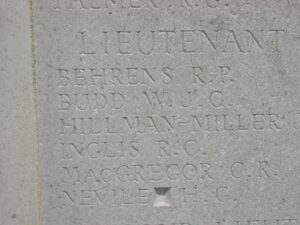
David Davies, Private, 43264, Welsh Regiment. David was the son of Evan and Sarah Davies, of Arddlas, Llansawel. He was a collier prior to the war and enlisted at Ammanford into the 3rd Battalion, Welsh Regiment, which was a reserve battalion, used as a training and feeder battalion for the 1st and 2nd Welsh. David was killed during a Machine Gun demonstration at Buttrils Camp, Penarth on 20 July 1916. He was stripping a Lewis Gun with a live round in the chamber, which went off and shot him. David was 26 years old, and his body was brought home for burial at Llansawel (Shiloh) Congregational Chapelyard.
John Idris Davies, Sergeant, 54512, Machine Gun Corps (Infantry). John was born at Llansawel, the son of Reverend Edward and Mary Davies. His parents later moved to Carmarthen, while John lived with his wife, Grace Catherine Davies, at 18, Broughton Road, West Ealing, London. John enlisted at Harrow into the 7th Battalion, Royal Welsh Fusiliers, but was later posted to the 232nd Company, Machine Gun Corps, which was attached to the 51st (Highland) Division. John joined his unit at Ypres in June 1917, when it was preparing for its part in the assault on Pilckem Ridge, alongside the Welsh Division. John was killed on 3 August 1917, during the Battle of Pilckem. He was 36 years old, and is buried at Artillery Wood Cemetery, Belgium.
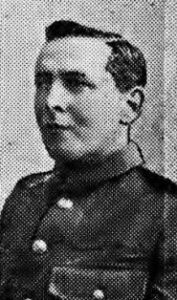
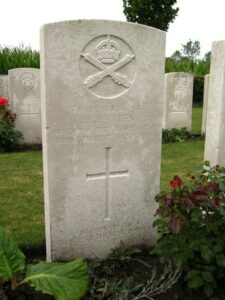
Oswyn St. Leger Davies, Lieutenant-Colonel, Manchester Regiment. Oswyn was the son of John Morgan Davies, D.L., J.P., and Jane Elizabeth Davies, of Froodvale. He was educated at Rugby School from May 1887, and left in December 1891. He then went into business, living in Manchester before moving to London. In 1899 he joined the Mounted Infantry Company of the Volunteer Battalion of the Manchester Regiment, and commanded it from 1904 to 1908, when it was disbanded under the Territorial Scheme. He then founded and organised the Welsh Rifle Association. On the outbreak of War he rejoined the Manchester Regiment, and went to Egypt in the autumn of 1914. In April 1915, he landed at Gallipoli with his battalion, and was wounded and sent home. He rejoined the battalion just before the evacuation of Gallipoli, and in 1916 was appointed to command the 8th Battalion, Lancashire Fusiliers, which was attached to 125 Brigade, 42nd Division. The Division then fought in Egypt, and on 27 February 1917 landed at Marseilles en route to the Western Front. The Division entered the line at Épehy then moved to Havrincourt where they remained until 8 July, facing the Hindenburg Line positions in front of Cambrai. July and August saw the Division training at Albert, and in September 1917 moved to Ypres to take part in the Battle of Third Ypres. After a series of unsuccessful attacks the Division moved to the Flanders Coast, and in November moved to Givenchy. When the German Spring Offensive of March 1918 was launched, Oswyn and his Battalion faced the onslaught at the Battle of Bapaume, and the First Battle of Arras. Oswyn was killed in action while leading a counter-attack on the village of Bucquoy on 5 April 1918, aged 44. He is buried at Bienvillers Military Cemetery, France. His medals and memorial plaque, together with two photographs of him, sold at auction in 2011 for £1,350.
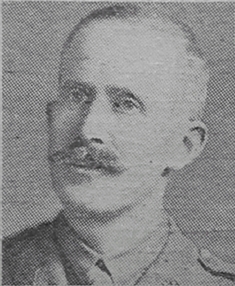
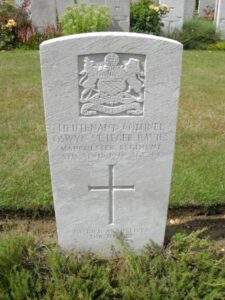
Rees Evans, Private, 37488, Royal Welsh Fusiliers. Rees was the son of David and Mary Evans, of Pencnwc, Llansawel. He worked as a farm labourer at Glanramell Park prior to the war, and enlisted on 11 December 1915 into the Royal Welsh Fusiliers. On 4 July 1916 he sailed for France, and two weeks later joined the 13th Battalion, Cheshire Regiment. The following month he was posted to the 1st Battalion, Royal Welsh Fusiliers, which was on the Somme attached to 22 Brigade, 7th Division. They then fought at the Battle of Bazentin, and the Attacks on High Wood, playing a successful part in the ‘dawn attack’, and were also the first troops into High Wood. The Division then took part in the Battle of Delville Wood, which is probably where Rees was killed on 21 August 1916, aged 20. He is buried at Lonsdale Cemetery, Authille, France. His mother also lost her brother Thomas Thomas during the war.
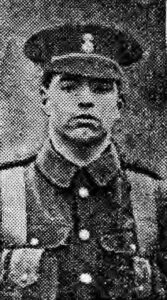
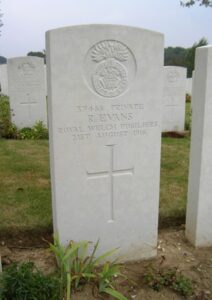
Evan Jones, Civilian, RMS Lusitania. Evan was the son of John and Joyse Jones, of Cwmhowel, Llansawel. He had emigrated to America in 1883, to escape a paternity lawsuit, and settled at Ottumwa, Iowa, where he worked as a coal miner, and became a naturalised American citizen in 1896. After almost 30 years living in the town, Evan decided to sell up and return to Llansawel, where his family and illegitimate daughter still lived, to see out the rest of his life. He sailed from New York on 1 May 1915, as a Third Class passenger aboard the RMS Lusitania, but was sadly drowned when Lusitania was torpedoed and sunk by the German submarine U-20 off the Old Head of Kinsale on 7 May 1915. Evan was 60 years old, and his body was not recovered from the sea. His death triggered off an international lawsuit, when his siblings fought a bitter battle over his substantial estate with Evan’s daughter.
Thomas John Jones, Private, 320238, Welsh Regiment. Thomas was the son of Lewis and Mary Anne Jones, of Tycefn, Llansawel. He originally enlisted into the Pembroke Yeomanry at Carmarthen, and sailed for Egypt with them in March 1916. After a year spent guarding the Suez Canal Defences, the Pembroke and Glamorgan Yeomanry were merged to form the 24th Battalion, Welsh Regiment, which became part of 231 Brigade, 74th (Yeomanry) Division. The Division took part in the move into Palestine, and fought in the Second and Third Battles of Gaza, which led to the successful capture of Jerusalem. Thomas was killed in Palestine on 6 November 1917, during the attack on the heights at Sheria. He was 27 years old, and is buried at Beersheba War Cemetery, Israel. His gravestone contains the inscription, translated from Welsh, ‘Without boastfulness after fighting, he remains with a cross above his place.’ Many thanks to Avril Marks for the photograph of Thomas’ grave.
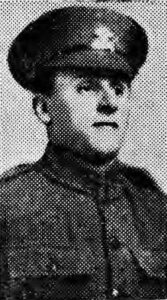
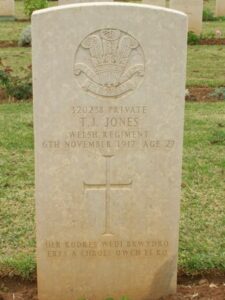
Wymond Howard Lloyd, Second Lieutenant, Herefordshire Regiment. Wymond was born on 20 March 1883, the eldest son of Howard Meuric Lloyd and Aimee Lloyd (nee Peel) of Delfryn, Talley. Wymond was educated at Malvern and New College, Oxford, where he had completed two years’ residence, and was half way through his degree and studying for the Civil Service. He rowed for his college in the second eight, and was a member of the O.U.O.T.C., and so was commissioned into the Herefordshire Regiment as a Second Lieutenant in September 1914. Wymond embarked with his regiment to Gallipoli in August, 1915, and was five weeks at Suvla before contracting enteric fever and dysentery, which required his return home after many weeks in hospital. Upon his return, he was posted to Park Hall Camp, Oswestry, engaged on light duty and hoped to pass for active service at a medical board on 23 March, but on 18 March he was struck by a train while walking near the camp, and brought to Oswestry Cottage Hospital, where he died the following day, on 19 March 1916. He was 22 years of age, and was brought home to be buried with military honours in Llangadock Cemetery, on 23 March 1916. The Colonel commanding the Welsh Division Grouped Depots, T.F., wrote:- “Your son was a very fine young officer, and had gained the love and respect of all who came into contact with him, both in Gallipoli and here. I regret his loss personally, for I know what good work he was doing here in the training of the men.”
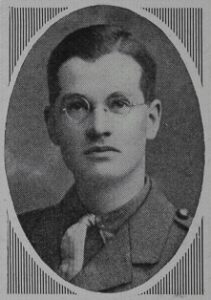
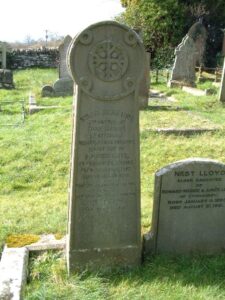
David Lewis Thomas, Private, 282286, Lancashire Fusiliers. David was the son of James and Anne Thomas, of Maesllan, Llansawel. He enlisted at Carmarthen into the Pembroke Yeomanry. He was one of a batch of men from the battalion posted to the 2/7th Battalion, Lancashire Fusiliers, who were in France attached to 197 Brigade, 66th (2nd East Lancs) Division. The Division concentrated on the Western Front by 16 March 1917 and moved to the Flanders Coast. At the end of September 1917 they moved to Ypres, and took part in the Battle of Poelcapelle. David was killed by shrapnel on 10 October 1917, aged 21. He is buried at Tyne Cot Military Cemetery, Belgium.
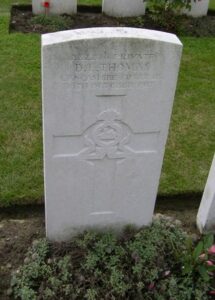
John Archibald Thomas, Private, Glamorgan Yeomanry. John was born in 1897, the son of John and Frances Elizabeth Thomas, of Edwinsford Forge, Talley. He had emigrated to Australia during 1908, where he worked as a farmer, but had returned home to visit his family in May 1914. The outbreak of war meant that John couldn’t return to Australia, so he enlisted into the Glamorgan Yeomanry. He survived the war, probably taking part in the Palestinian campaign with the 24th Welsh, before being demobilised, and set up home temporarily at 2, Claremont Villas, Carmarthen, while he awaited a chance to return to Australia. John had suffered from depression since leaving the army, and was said to be worried about being able to return to Australia. He was discovered dead at Capel Evan, near Wellfield Road, Carmarthen on Monday 22 September 1919, and an autopsy showed that he had killed himself by cutting his own throat with a razor. John was 30 years old, and was buried at Carmarthen. No more is presently known of him, and he is not commemorated on any war memorial, even though his depression was brought on by his service.
Thomas Thomas, Lance Corporal, 19768, Welsh Regiment. Thomas was born at Llansawel, and was the Husband of Louie Thomas, of 62, Roath Court Road, Cardiff. He enlisted at Mountain Ash into the Welsh Regiment, and was posted to the 2nd Battalion, Welsh Regiment, which was in France attached to 3 Brigade, 1st Division. Thomas probably fought at the Battle of Loos with the Division from September 1915 onwards, and the following year saw the Division on the Somme. Thomas was killed during the Battle of Guillemont, on 8 September 1916. He was 32 years old, and is commemorated on the Thiepval Memorial, France. His nephew, Rees Evans, also fell.
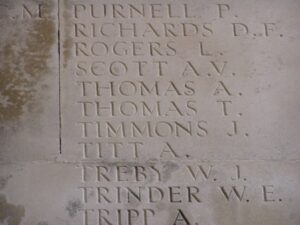
World War Two, 1939-1945
Stanley Pumpsaint Davies, Leading Aircraftman, 1120793, Royal Air Force Volunteer Reserve. Stanley was the son of John and Ellen Davies, of Tyisaf, Llansawel. He lived with his wife Phyllis Vera Davies, at Llansawel. Little is presently known of Stanley, but he died on active service on 24 January 1946, aged 37, and is buried in Llansawel (Bethel) Methodist New Cemetery.